Microeconomic Analysis of Australian Housing Market - Supply & Demand
VerifiedAdded on 2023/06/11
|9
|2167
|148
Report
AI Summary
This report provides a microeconomic analysis of the Australian housing market, focusing on the cities of Sydney and Melbourne. It examines the interplay of supply and demand, price elasticity, and production costs in determining housing prices. The analysis is based on a media article that discusses the recent decline in housing prices due to increased supply, government regulations, and reduced credit facilities. The report applies microeconomic concepts such as the laws of supply and demand, price elasticity of demand and supply, and the impact of production costs on housing prices. It also considers the potential effects of population growth on future housing demand and prices. The report concludes that the Australian housing market is subject to price elasticities of demand and supply, and that changes in production costs, influenced by interest rates and lending constraints, significantly affect the supply of housing facilities.
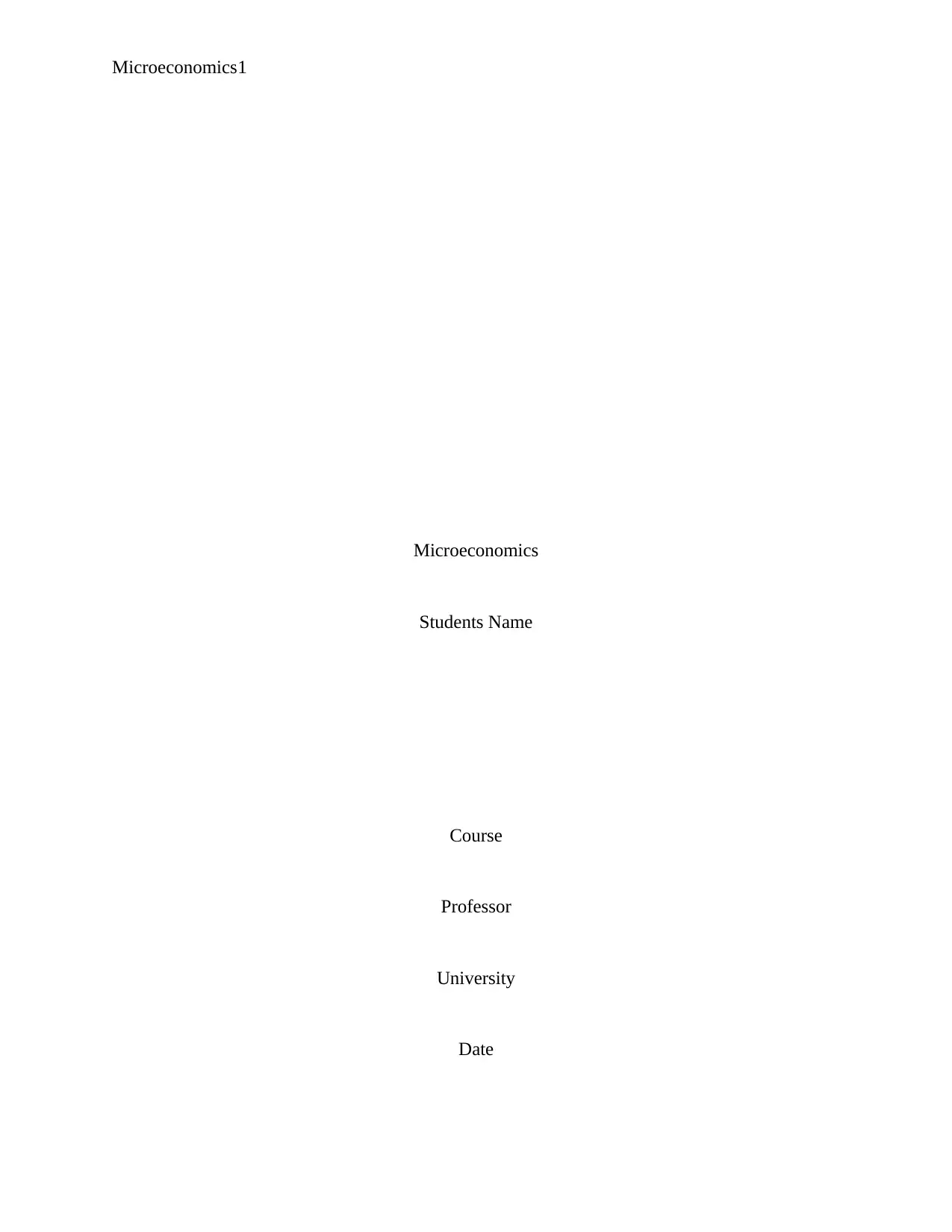
Microeconomics1
Microeconomics
Students Name
Course
Professor
University
Date
Microeconomics
Students Name
Course
Professor
University
Date
Paraphrase This Document
Need a fresh take? Get an instant paraphrase of this document with our AI Paraphraser
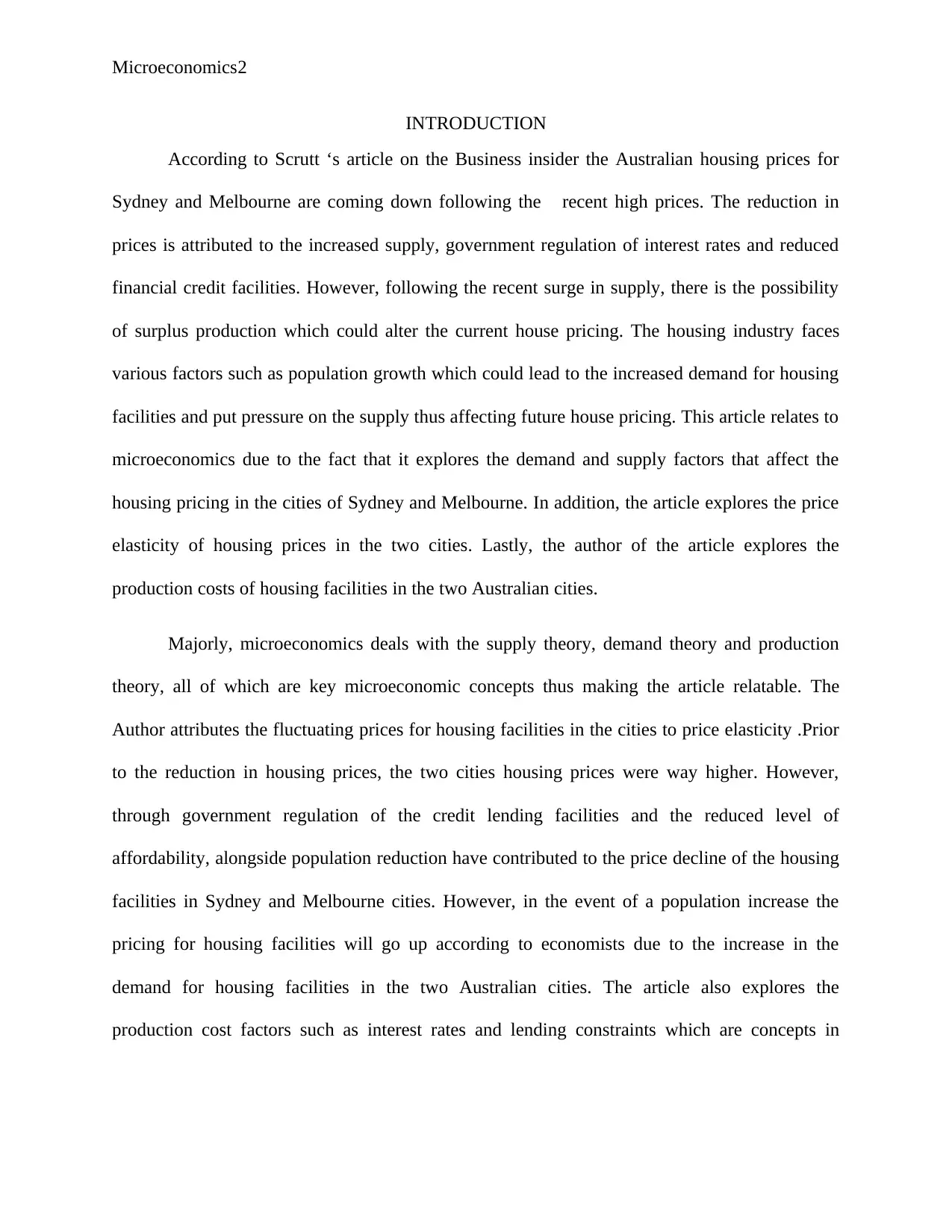
Microeconomics2
INTRODUCTION
According to Scrutt ‘s article on the Business insider the Australian housing prices for
Sydney and Melbourne are coming down following the recent high prices. The reduction in
prices is attributed to the increased supply, government regulation of interest rates and reduced
financial credit facilities. However, following the recent surge in supply, there is the possibility
of surplus production which could alter the current house pricing. The housing industry faces
various factors such as population growth which could lead to the increased demand for housing
facilities and put pressure on the supply thus affecting future house pricing. This article relates to
microeconomics due to the fact that it explores the demand and supply factors that affect the
housing pricing in the cities of Sydney and Melbourne. In addition, the article explores the price
elasticity of housing prices in the two cities. Lastly, the author of the article explores the
production costs of housing facilities in the two Australian cities.
Majorly, microeconomics deals with the supply theory, demand theory and production
theory, all of which are key microeconomic concepts thus making the article relatable. The
Author attributes the fluctuating prices for housing facilities in the cities to price elasticity .Prior
to the reduction in housing prices, the two cities housing prices were way higher. However,
through government regulation of the credit lending facilities and the reduced level of
affordability, alongside population reduction have contributed to the price decline of the housing
facilities in Sydney and Melbourne cities. However, in the event of a population increase the
pricing for housing facilities will go up according to economists due to the increase in the
demand for housing facilities in the two Australian cities. The article also explores the
production cost factors such as interest rates and lending constraints which are concepts in
INTRODUCTION
According to Scrutt ‘s article on the Business insider the Australian housing prices for
Sydney and Melbourne are coming down following the recent high prices. The reduction in
prices is attributed to the increased supply, government regulation of interest rates and reduced
financial credit facilities. However, following the recent surge in supply, there is the possibility
of surplus production which could alter the current house pricing. The housing industry faces
various factors such as population growth which could lead to the increased demand for housing
facilities and put pressure on the supply thus affecting future house pricing. This article relates to
microeconomics due to the fact that it explores the demand and supply factors that affect the
housing pricing in the cities of Sydney and Melbourne. In addition, the article explores the price
elasticity of housing prices in the two cities. Lastly, the author of the article explores the
production costs of housing facilities in the two Australian cities.
Majorly, microeconomics deals with the supply theory, demand theory and production
theory, all of which are key microeconomic concepts thus making the article relatable. The
Author attributes the fluctuating prices for housing facilities in the cities to price elasticity .Prior
to the reduction in housing prices, the two cities housing prices were way higher. However,
through government regulation of the credit lending facilities and the reduced level of
affordability, alongside population reduction have contributed to the price decline of the housing
facilities in Sydney and Melbourne cities. However, in the event of a population increase the
pricing for housing facilities will go up according to economists due to the increase in the
demand for housing facilities in the two Australian cities. The article also explores the
production cost factors such as interest rates and lending constraints which are concepts in
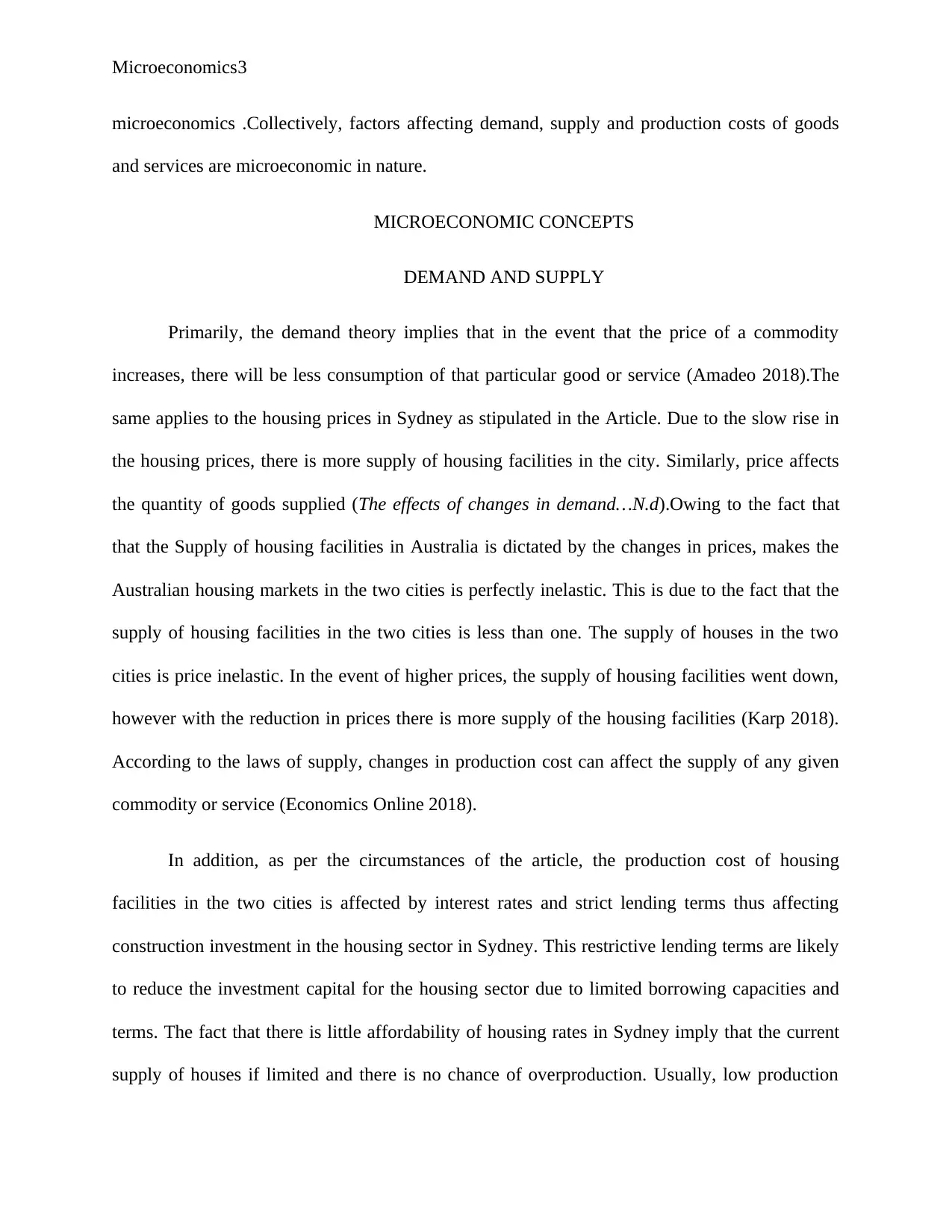
Microeconomics3
microeconomics .Collectively, factors affecting demand, supply and production costs of goods
and services are microeconomic in nature.
MICROECONOMIC CONCEPTS
DEMAND AND SUPPLY
Primarily, the demand theory implies that in the event that the price of a commodity
increases, there will be less consumption of that particular good or service (Amadeo 2018).The
same applies to the housing prices in Sydney as stipulated in the Article. Due to the slow rise in
the housing prices, there is more supply of housing facilities in the city. Similarly, price affects
the quantity of goods supplied (The effects of changes in demand…N.d).Owing to the fact that
that the Supply of housing facilities in Australia is dictated by the changes in prices, makes the
Australian housing markets in the two cities is perfectly inelastic. This is due to the fact that the
supply of housing facilities in the two cities is less than one. The supply of houses in the two
cities is price inelastic. In the event of higher prices, the supply of housing facilities went down,
however with the reduction in prices there is more supply of the housing facilities (Karp 2018).
According to the laws of supply, changes in production cost can affect the supply of any given
commodity or service (Economics Online 2018).
In addition, as per the circumstances of the article, the production cost of housing
facilities in the two cities is affected by interest rates and strict lending terms thus affecting
construction investment in the housing sector in Sydney. This restrictive lending terms are likely
to reduce the investment capital for the housing sector due to limited borrowing capacities and
terms. The fact that there is little affordability of housing rates in Sydney imply that the current
supply of houses if limited and there is no chance of overproduction. Usually, low production
microeconomics .Collectively, factors affecting demand, supply and production costs of goods
and services are microeconomic in nature.
MICROECONOMIC CONCEPTS
DEMAND AND SUPPLY
Primarily, the demand theory implies that in the event that the price of a commodity
increases, there will be less consumption of that particular good or service (Amadeo 2018).The
same applies to the housing prices in Sydney as stipulated in the Article. Due to the slow rise in
the housing prices, there is more supply of housing facilities in the city. Similarly, price affects
the quantity of goods supplied (The effects of changes in demand…N.d).Owing to the fact that
that the Supply of housing facilities in Australia is dictated by the changes in prices, makes the
Australian housing markets in the two cities is perfectly inelastic. This is due to the fact that the
supply of housing facilities in the two cities is less than one. The supply of houses in the two
cities is price inelastic. In the event of higher prices, the supply of housing facilities went down,
however with the reduction in prices there is more supply of the housing facilities (Karp 2018).
According to the laws of supply, changes in production cost can affect the supply of any given
commodity or service (Economics Online 2018).
In addition, as per the circumstances of the article, the production cost of housing
facilities in the two cities is affected by interest rates and strict lending terms thus affecting
construction investment in the housing sector in Sydney. This restrictive lending terms are likely
to reduce the investment capital for the housing sector due to limited borrowing capacities and
terms. The fact that there is little affordability of housing rates in Sydney imply that the current
supply of houses if limited and there is no chance of overproduction. Usually, low production
⊘ This is a preview!⊘
Do you want full access?
Subscribe today to unlock all pages.

Trusted by 1+ million students worldwide
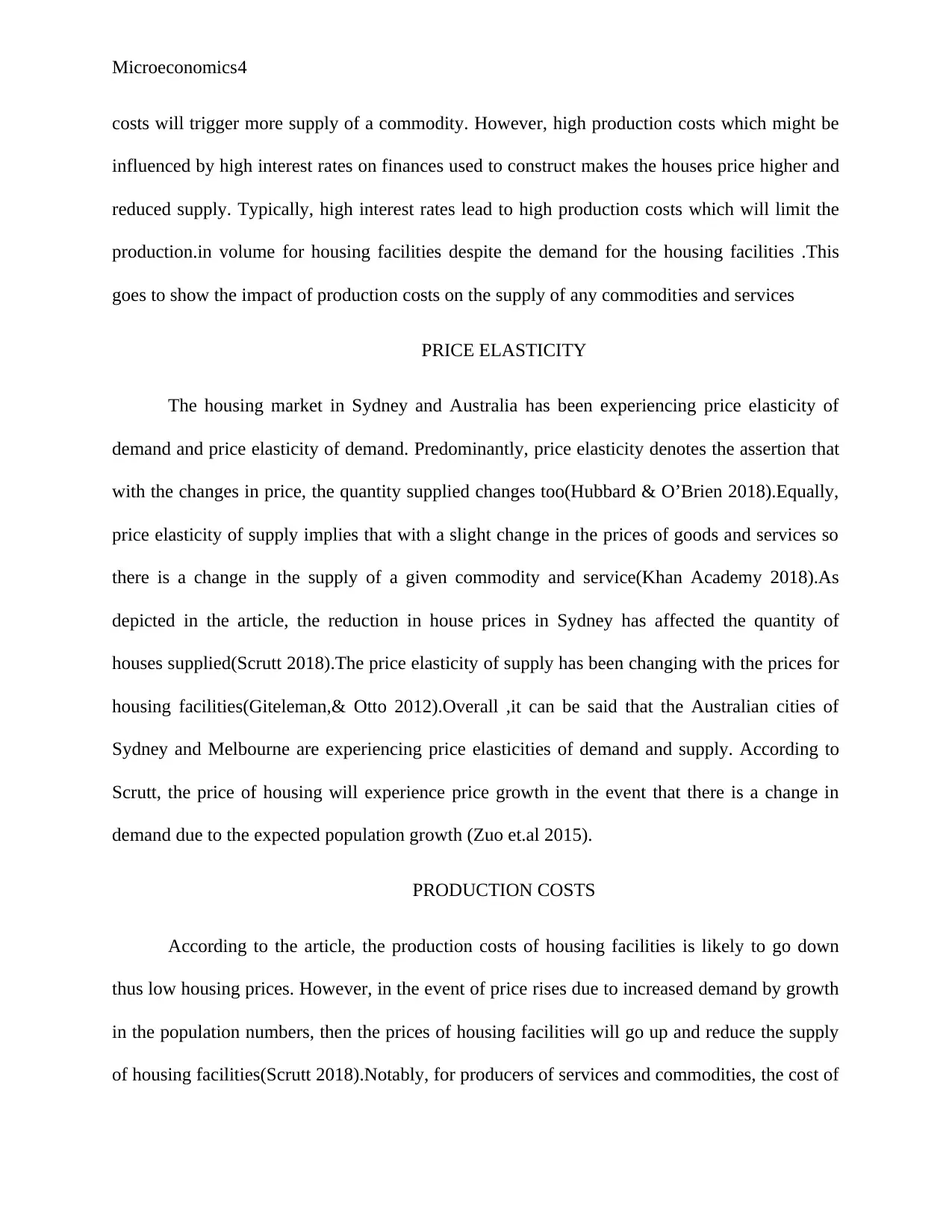
Microeconomics4
costs will trigger more supply of a commodity. However, high production costs which might be
influenced by high interest rates on finances used to construct makes the houses price higher and
reduced supply. Typically, high interest rates lead to high production costs which will limit the
production.in volume for housing facilities despite the demand for the housing facilities .This
goes to show the impact of production costs on the supply of any commodities and services
PRICE ELASTICITY
The housing market in Sydney and Australia has been experiencing price elasticity of
demand and price elasticity of demand. Predominantly, price elasticity denotes the assertion that
with the changes in price, the quantity supplied changes too(Hubbard & O’Brien 2018).Equally,
price elasticity of supply implies that with a slight change in the prices of goods and services so
there is a change in the supply of a given commodity and service(Khan Academy 2018).As
depicted in the article, the reduction in house prices in Sydney has affected the quantity of
houses supplied(Scrutt 2018).The price elasticity of supply has been changing with the prices for
housing facilities(Giteleman,& Otto 2012).Overall ,it can be said that the Australian cities of
Sydney and Melbourne are experiencing price elasticities of demand and supply. According to
Scrutt, the price of housing will experience price growth in the event that there is a change in
demand due to the expected population growth (Zuo et.al 2015).
PRODUCTION COSTS
According to the article, the production costs of housing facilities is likely to go down
thus low housing prices. However, in the event of price rises due to increased demand by growth
in the population numbers, then the prices of housing facilities will go up and reduce the supply
of housing facilities(Scrutt 2018).Notably, for producers of services and commodities, the cost of
costs will trigger more supply of a commodity. However, high production costs which might be
influenced by high interest rates on finances used to construct makes the houses price higher and
reduced supply. Typically, high interest rates lead to high production costs which will limit the
production.in volume for housing facilities despite the demand for the housing facilities .This
goes to show the impact of production costs on the supply of any commodities and services
PRICE ELASTICITY
The housing market in Sydney and Australia has been experiencing price elasticity of
demand and price elasticity of demand. Predominantly, price elasticity denotes the assertion that
with the changes in price, the quantity supplied changes too(Hubbard & O’Brien 2018).Equally,
price elasticity of supply implies that with a slight change in the prices of goods and services so
there is a change in the supply of a given commodity and service(Khan Academy 2018).As
depicted in the article, the reduction in house prices in Sydney has affected the quantity of
houses supplied(Scrutt 2018).The price elasticity of supply has been changing with the prices for
housing facilities(Giteleman,& Otto 2012).Overall ,it can be said that the Australian cities of
Sydney and Melbourne are experiencing price elasticities of demand and supply. According to
Scrutt, the price of housing will experience price growth in the event that there is a change in
demand due to the expected population growth (Zuo et.al 2015).
PRODUCTION COSTS
According to the article, the production costs of housing facilities is likely to go down
thus low housing prices. However, in the event of price rises due to increased demand by growth
in the population numbers, then the prices of housing facilities will go up and reduce the supply
of housing facilities(Scrutt 2018).Notably, for producers of services and commodities, the cost of
Paraphrase This Document
Need a fresh take? Get an instant paraphrase of this document with our AI Paraphraser
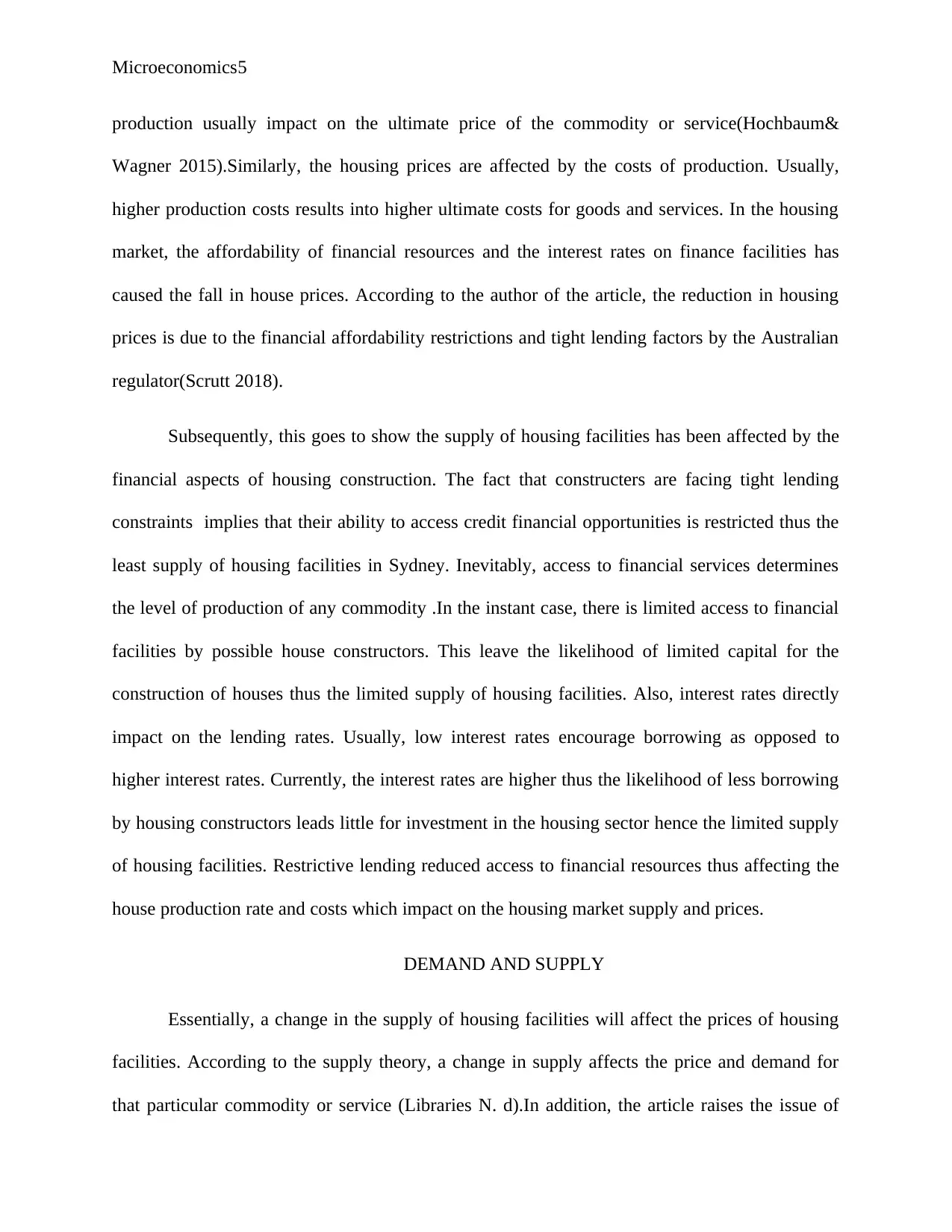
Microeconomics5
production usually impact on the ultimate price of the commodity or service(Hochbaum&
Wagner 2015).Similarly, the housing prices are affected by the costs of production. Usually,
higher production costs results into higher ultimate costs for goods and services. In the housing
market, the affordability of financial resources and the interest rates on finance facilities has
caused the fall in house prices. According to the author of the article, the reduction in housing
prices is due to the financial affordability restrictions and tight lending factors by the Australian
regulator(Scrutt 2018).
Subsequently, this goes to show the supply of housing facilities has been affected by the
financial aspects of housing construction. The fact that constructers are facing tight lending
constraints implies that their ability to access credit financial opportunities is restricted thus the
least supply of housing facilities in Sydney. Inevitably, access to financial services determines
the level of production of any commodity .In the instant case, there is limited access to financial
facilities by possible house constructors. This leave the likelihood of limited capital for the
construction of houses thus the limited supply of housing facilities. Also, interest rates directly
impact on the lending rates. Usually, low interest rates encourage borrowing as opposed to
higher interest rates. Currently, the interest rates are higher thus the likelihood of less borrowing
by housing constructors leads little for investment in the housing sector hence the limited supply
of housing facilities. Restrictive lending reduced access to financial resources thus affecting the
house production rate and costs which impact on the housing market supply and prices.
DEMAND AND SUPPLY
Essentially, a change in the supply of housing facilities will affect the prices of housing
facilities. According to the supply theory, a change in supply affects the price and demand for
that particular commodity or service (Libraries N. d).In addition, the article raises the issue of
production usually impact on the ultimate price of the commodity or service(Hochbaum&
Wagner 2015).Similarly, the housing prices are affected by the costs of production. Usually,
higher production costs results into higher ultimate costs for goods and services. In the housing
market, the affordability of financial resources and the interest rates on finance facilities has
caused the fall in house prices. According to the author of the article, the reduction in housing
prices is due to the financial affordability restrictions and tight lending factors by the Australian
regulator(Scrutt 2018).
Subsequently, this goes to show the supply of housing facilities has been affected by the
financial aspects of housing construction. The fact that constructers are facing tight lending
constraints implies that their ability to access credit financial opportunities is restricted thus the
least supply of housing facilities in Sydney. Inevitably, access to financial services determines
the level of production of any commodity .In the instant case, there is limited access to financial
facilities by possible house constructors. This leave the likelihood of limited capital for the
construction of houses thus the limited supply of housing facilities. Also, interest rates directly
impact on the lending rates. Usually, low interest rates encourage borrowing as opposed to
higher interest rates. Currently, the interest rates are higher thus the likelihood of less borrowing
by housing constructors leads little for investment in the housing sector hence the limited supply
of housing facilities. Restrictive lending reduced access to financial resources thus affecting the
house production rate and costs which impact on the housing market supply and prices.
DEMAND AND SUPPLY
Essentially, a change in the supply of housing facilities will affect the prices of housing
facilities. According to the supply theory, a change in supply affects the price and demand for
that particular commodity or service (Libraries N. d).In addition, the article raises the issue of
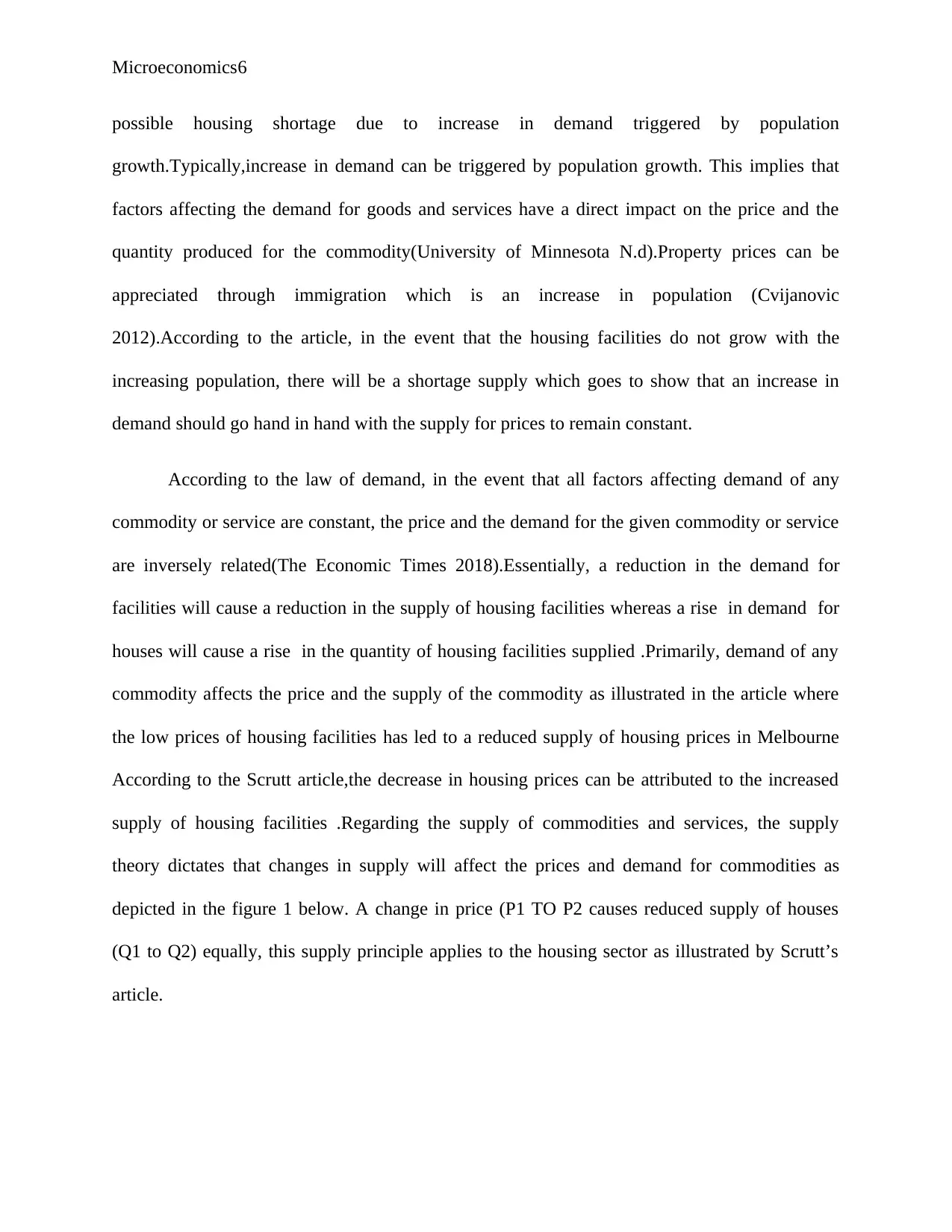
Microeconomics6
possible housing shortage due to increase in demand triggered by population
growth.Typically,increase in demand can be triggered by population growth. This implies that
factors affecting the demand for goods and services have a direct impact on the price and the
quantity produced for the commodity(University of Minnesota N.d).Property prices can be
appreciated through immigration which is an increase in population (Cvijanovic
2012).According to the article, in the event that the housing facilities do not grow with the
increasing population, there will be a shortage supply which goes to show that an increase in
demand should go hand in hand with the supply for prices to remain constant.
According to the law of demand, in the event that all factors affecting demand of any
commodity or service are constant, the price and the demand for the given commodity or service
are inversely related(The Economic Times 2018).Essentially, a reduction in the demand for
facilities will cause a reduction in the supply of housing facilities whereas a rise in demand for
houses will cause a rise in the quantity of housing facilities supplied .Primarily, demand of any
commodity affects the price and the supply of the commodity as illustrated in the article where
the low prices of housing facilities has led to a reduced supply of housing prices in Melbourne
According to the Scrutt article,the decrease in housing prices can be attributed to the increased
supply of housing facilities .Regarding the supply of commodities and services, the supply
theory dictates that changes in supply will affect the prices and demand for commodities as
depicted in the figure 1 below. A change in price (P1 TO P2 causes reduced supply of houses
(Q1 to Q2) equally, this supply principle applies to the housing sector as illustrated by Scrutt’s
article.
possible housing shortage due to increase in demand triggered by population
growth.Typically,increase in demand can be triggered by population growth. This implies that
factors affecting the demand for goods and services have a direct impact on the price and the
quantity produced for the commodity(University of Minnesota N.d).Property prices can be
appreciated through immigration which is an increase in population (Cvijanovic
2012).According to the article, in the event that the housing facilities do not grow with the
increasing population, there will be a shortage supply which goes to show that an increase in
demand should go hand in hand with the supply for prices to remain constant.
According to the law of demand, in the event that all factors affecting demand of any
commodity or service are constant, the price and the demand for the given commodity or service
are inversely related(The Economic Times 2018).Essentially, a reduction in the demand for
facilities will cause a reduction in the supply of housing facilities whereas a rise in demand for
houses will cause a rise in the quantity of housing facilities supplied .Primarily, demand of any
commodity affects the price and the supply of the commodity as illustrated in the article where
the low prices of housing facilities has led to a reduced supply of housing prices in Melbourne
According to the Scrutt article,the decrease in housing prices can be attributed to the increased
supply of housing facilities .Regarding the supply of commodities and services, the supply
theory dictates that changes in supply will affect the prices and demand for commodities as
depicted in the figure 1 below. A change in price (P1 TO P2 causes reduced supply of houses
(Q1 to Q2) equally, this supply principle applies to the housing sector as illustrated by Scrutt’s
article.
⊘ This is a preview!⊘
Do you want full access?
Subscribe today to unlock all pages.

Trusted by 1+ million students worldwide
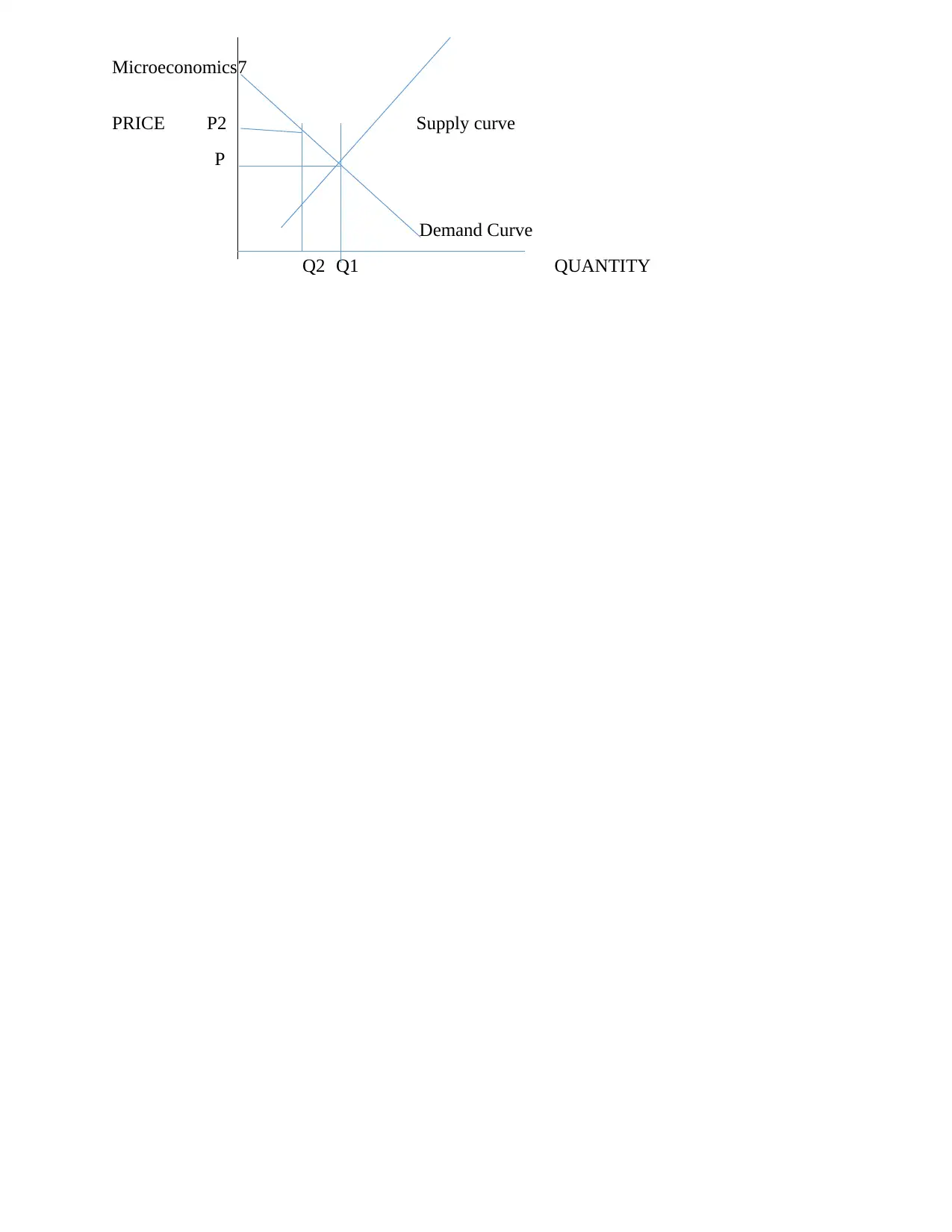
Microeconomics7
PRICE P2 Supply curve
P
Demand Curve
Q2 Q1 QUANTITY
PRICE P2 Supply curve
P
Demand Curve
Q2 Q1 QUANTITY
Paraphrase This Document
Need a fresh take? Get an instant paraphrase of this document with our AI Paraphraser
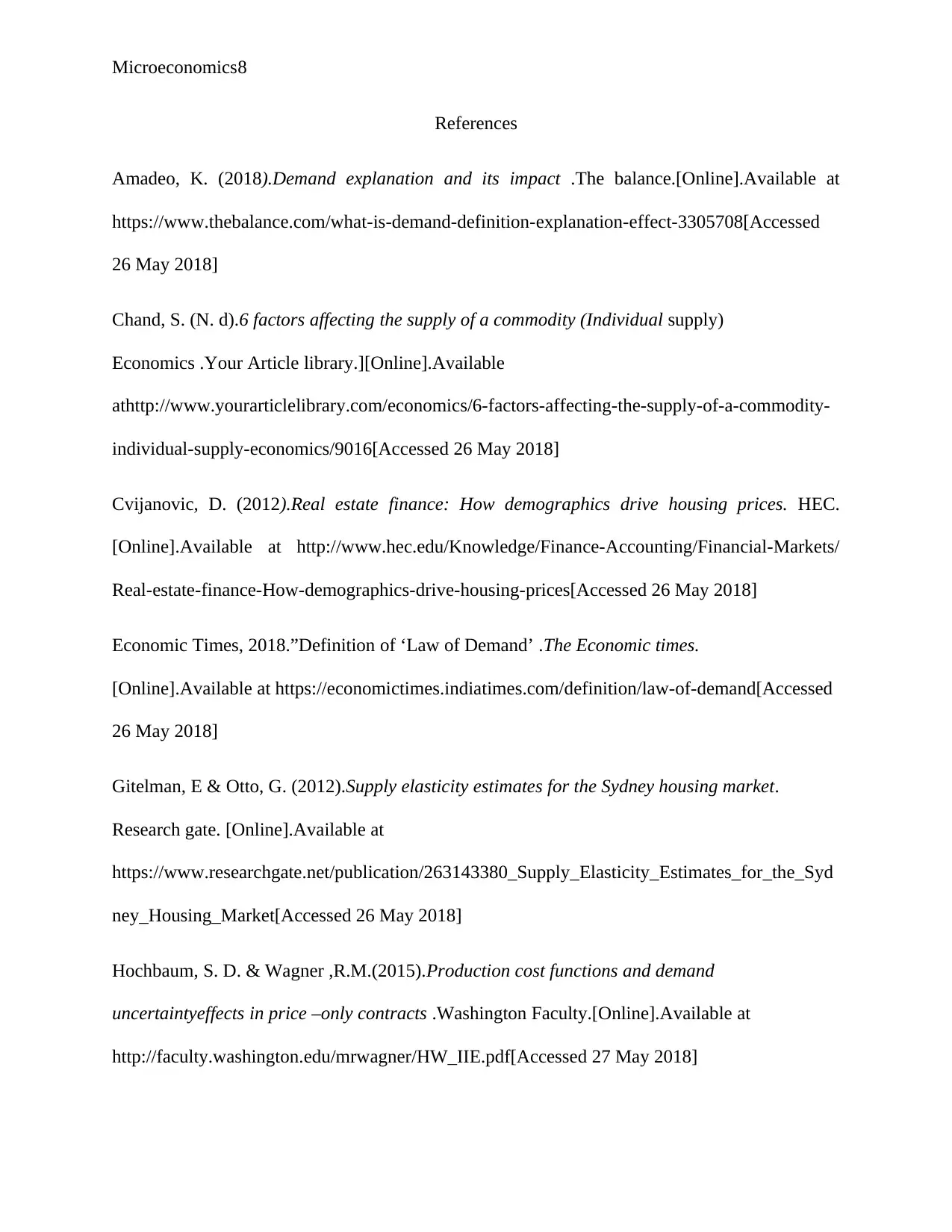
Microeconomics8
References
Amadeo, K. (2018).Demand explanation and its impact .The balance.[Online].Available at
https://www.thebalance.com/what-is-demand-definition-explanation-effect-3305708[Accessed
26 May 2018]
Chand, S. (N. d).6 factors affecting the supply of a commodity (Individual supply)
Economics .Your Article library.][Online].Available
athttp://www.yourarticlelibrary.com/economics/6-factors-affecting-the-supply-of-a-commodity-
individual-supply-economics/9016[Accessed 26 May 2018]
Cvijanovic, D. (2012).Real estate finance: How demographics drive housing prices. HEC.
[Online].Available at http://www.hec.edu/Knowledge/Finance-Accounting/Financial-Markets/
Real-estate-finance-How-demographics-drive-housing-prices[Accessed 26 May 2018]
Economic Times, 2018.”Definition of ‘Law of Demand’ .The Economic times.
[Online].Available at https://economictimes.indiatimes.com/definition/law-of-demand[Accessed
26 May 2018]
Gitelman, E & Otto, G. (2012).Supply elasticity estimates for the Sydney housing market.
Research gate. [Online].Available at
https://www.researchgate.net/publication/263143380_Supply_Elasticity_Estimates_for_the_Syd
ney_Housing_Market[Accessed 26 May 2018]
Hochbaum, S. D. & Wagner ,R.M.(2015).Production cost functions and demand
uncertaintyeffects in price –only contracts .Washington Faculty.[Online].Available at
http://faculty.washington.edu/mrwagner/HW_IIE.pdf[Accessed 27 May 2018]
References
Amadeo, K. (2018).Demand explanation and its impact .The balance.[Online].Available at
https://www.thebalance.com/what-is-demand-definition-explanation-effect-3305708[Accessed
26 May 2018]
Chand, S. (N. d).6 factors affecting the supply of a commodity (Individual supply)
Economics .Your Article library.][Online].Available
athttp://www.yourarticlelibrary.com/economics/6-factors-affecting-the-supply-of-a-commodity-
individual-supply-economics/9016[Accessed 26 May 2018]
Cvijanovic, D. (2012).Real estate finance: How demographics drive housing prices. HEC.
[Online].Available at http://www.hec.edu/Knowledge/Finance-Accounting/Financial-Markets/
Real-estate-finance-How-demographics-drive-housing-prices[Accessed 26 May 2018]
Economic Times, 2018.”Definition of ‘Law of Demand’ .The Economic times.
[Online].Available at https://economictimes.indiatimes.com/definition/law-of-demand[Accessed
26 May 2018]
Gitelman, E & Otto, G. (2012).Supply elasticity estimates for the Sydney housing market.
Research gate. [Online].Available at
https://www.researchgate.net/publication/263143380_Supply_Elasticity_Estimates_for_the_Syd
ney_Housing_Market[Accessed 26 May 2018]
Hochbaum, S. D. & Wagner ,R.M.(2015).Production cost functions and demand
uncertaintyeffects in price –only contracts .Washington Faculty.[Online].Available at
http://faculty.washington.edu/mrwagner/HW_IIE.pdf[Accessed 27 May 2018]
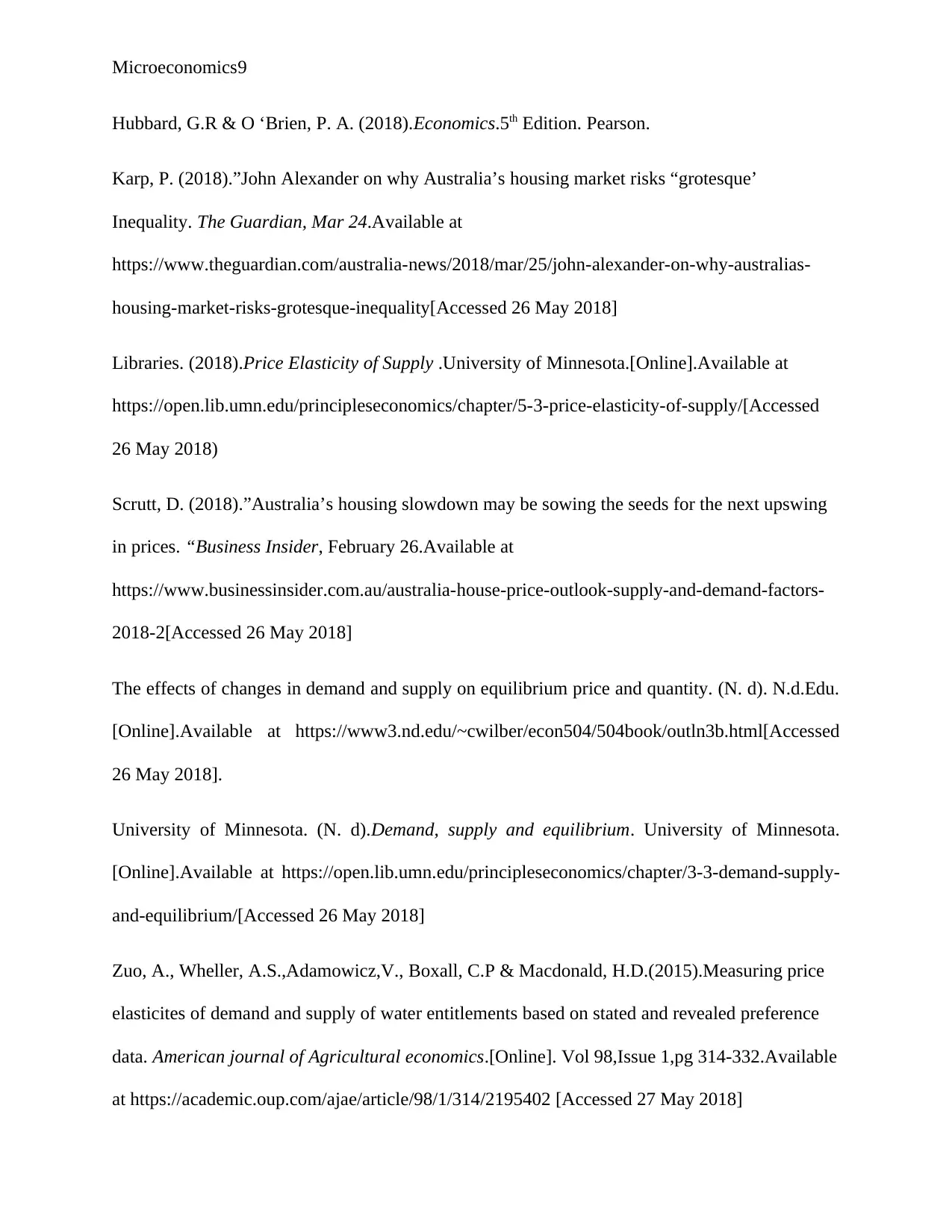
Microeconomics9
Hubbard, G.R & O ‘Brien, P. A. (2018).Economics.5th Edition. Pearson.
Karp, P. (2018).”John Alexander on why Australia’s housing market risks “grotesque’
Inequality. The Guardian, Mar 24.Available at
https://www.theguardian.com/australia-news/2018/mar/25/john-alexander-on-why-australias-
housing-market-risks-grotesque-inequality[Accessed 26 May 2018]
Libraries. (2018).Price Elasticity of Supply .University of Minnesota.[Online].Available at
https://open.lib.umn.edu/principleseconomics/chapter/5-3-price-elasticity-of-supply/[Accessed
26 May 2018)
Scrutt, D. (2018).”Australia’s housing slowdown may be sowing the seeds for the next upswing
in prices. “Business Insider, February 26.Available at
https://www.businessinsider.com.au/australia-house-price-outlook-supply-and-demand-factors-
2018-2[Accessed 26 May 2018]
The effects of changes in demand and supply on equilibrium price and quantity. (N. d). N.d.Edu.
[Online].Available at https://www3.nd.edu/~cwilber/econ504/504book/outln3b.html[Accessed
26 May 2018].
University of Minnesota. (N. d).Demand, supply and equilibrium. University of Minnesota.
[Online].Available at https://open.lib.umn.edu/principleseconomics/chapter/3-3-demand-supply-
and-equilibrium/[Accessed 26 May 2018]
Zuo, A., Wheller, A.S.,Adamowicz,V., Boxall, C.P & Macdonald, H.D.(2015).Measuring price
elasticites of demand and supply of water entitlements based on stated and revealed preference
data. American journal of Agricultural economics.[Online]. Vol 98,Issue 1,pg 314-332.Available
at https://academic.oup.com/ajae/article/98/1/314/2195402 [Accessed 27 May 2018]
Hubbard, G.R & O ‘Brien, P. A. (2018).Economics.5th Edition. Pearson.
Karp, P. (2018).”John Alexander on why Australia’s housing market risks “grotesque’
Inequality. The Guardian, Mar 24.Available at
https://www.theguardian.com/australia-news/2018/mar/25/john-alexander-on-why-australias-
housing-market-risks-grotesque-inequality[Accessed 26 May 2018]
Libraries. (2018).Price Elasticity of Supply .University of Minnesota.[Online].Available at
https://open.lib.umn.edu/principleseconomics/chapter/5-3-price-elasticity-of-supply/[Accessed
26 May 2018)
Scrutt, D. (2018).”Australia’s housing slowdown may be sowing the seeds for the next upswing
in prices. “Business Insider, February 26.Available at
https://www.businessinsider.com.au/australia-house-price-outlook-supply-and-demand-factors-
2018-2[Accessed 26 May 2018]
The effects of changes in demand and supply on equilibrium price and quantity. (N. d). N.d.Edu.
[Online].Available at https://www3.nd.edu/~cwilber/econ504/504book/outln3b.html[Accessed
26 May 2018].
University of Minnesota. (N. d).Demand, supply and equilibrium. University of Minnesota.
[Online].Available at https://open.lib.umn.edu/principleseconomics/chapter/3-3-demand-supply-
and-equilibrium/[Accessed 26 May 2018]
Zuo, A., Wheller, A.S.,Adamowicz,V., Boxall, C.P & Macdonald, H.D.(2015).Measuring price
elasticites of demand and supply of water entitlements based on stated and revealed preference
data. American journal of Agricultural economics.[Online]. Vol 98,Issue 1,pg 314-332.Available
at https://academic.oup.com/ajae/article/98/1/314/2195402 [Accessed 27 May 2018]
⊘ This is a preview!⊘
Do you want full access?
Subscribe today to unlock all pages.

Trusted by 1+ million students worldwide
1 out of 9
Related Documents
Your All-in-One AI-Powered Toolkit for Academic Success.
+13062052269
info@desklib.com
Available 24*7 on WhatsApp / Email
![[object Object]](/_next/static/media/star-bottom.7253800d.svg)
Unlock your academic potential
Copyright © 2020–2025 A2Z Services. All Rights Reserved. Developed and managed by ZUCOL.





